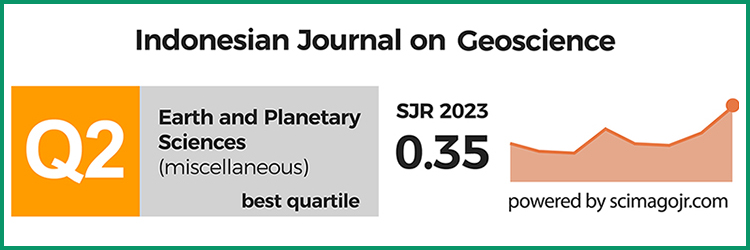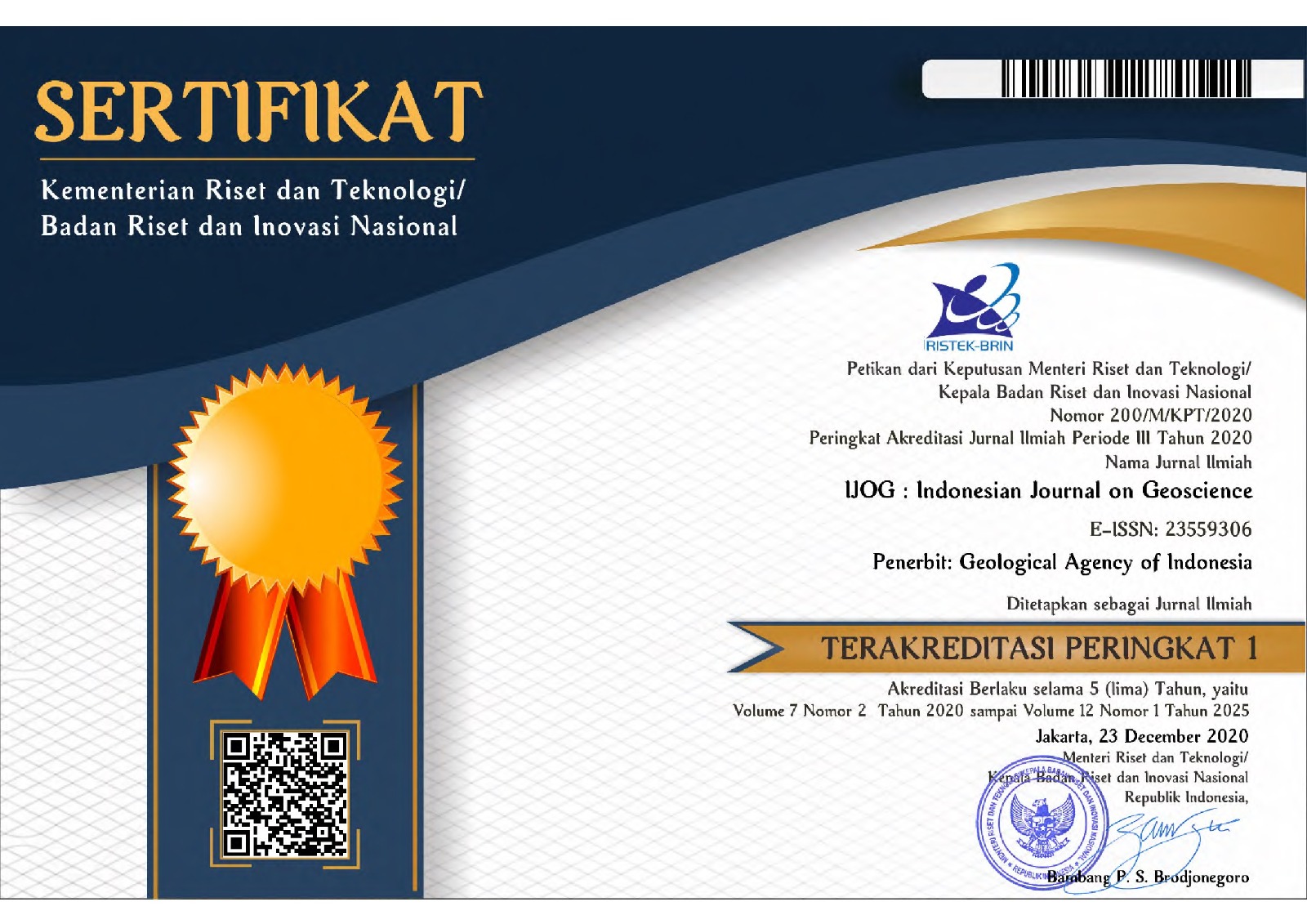Wireline Log Responses, Mudweight, Clay Mineralogy, and Implied Overpressure Condition: Insights from Aru Field, North Sumatra Basin
DOI:
https://doi.org/10.17014/ijog.7.2.105-119Keywords:
North Sumatra Basin, overpressure, underbalance, loading, smectite and illite compactionAbstract
DOI:10.17014/ijog.7.2.105-119
This paper comprehensively discusses overpressuring in the North Sumatra Basin by using wireline log, drilling events and parameters, and clay mineralogical data. It shows an interesting phenomenon related to overpressuring in this basin, i.e. strong log reversals indicating high overpressure, yet the mudweight used during drilling was relatively low, indicating low overpressure with no significant drilling events noted in the final well report.The result of the study shows that wireline log is the best parameter to imply overpressure magnitude. Regarding low mudweight in the strong log reversal zone, it would be elucidated that the drilling in that zone was in underbalance condition with respect to shale pressure, but not to sandstone pressure. The sandstone pressure is interpreted to be lower than shale pressure due to lateral drainage process. By applying the Eaton’s method, the estimated maximum overpressure magnitude in the Baong Formation is in the range of 1,594 - 3,185 psi. or equivalent to the mudweight of 1.61 - 192 g/cm3. The analysis of wireline log in combination with clay mineralogical data shows that there are two compaction lines in the studied area, i.e. smectitic and illitic compaction lines. The cross-plot of density and sonic logs in shale section suggest that the cause of overpressure was loading mechanism. The scanning electron microscope (SEM) image confirms that in overpressure zone, grain to grain contact is still able to be observed fairly well, inferring that loading mechanism is really the cause of overpressure in the studied area.
References
Aziz, A. and Bolt, L.H. 1984. Occurrence and detection of abnormal pressures from geological and drilling data, North Sumatra Basin. Proceedings 13th Indonesian Petroleum Association Annual Convention, p. 195 – 220, Jakarta. DOI:10.29118/ipa.1191.195.220
Barber, A.J. and Crow, M.J. 2005. Structure and structural history. In: Barber, A.J., Crow, M.J., and Milsom, J.S., Sumatra: Geology, Resources, and Tectonic Evolution, Geological Society of London Memoir No. 31. DOI:10.1017/S0016756806212974
Bowers, G.L. 1995. Pore pressure estimation from velocity data: accounting for overpressure mechanisms besides undercompaction. SPE Drilling and Completion, p. 89 – 95. DOI:10.2118/27488-PA
Cameron, N.R., Clarke, M.C.G., Aldiss, D.T., Aspden, J.A., and Djunuddin, A. 1980. The geological evolution of northern Sumatra. Proceedings 9th Indonesian Petroleum Association Annual Convention, p. 149 – 188.
Davies, P.R. 1984. Tertiary structural evolution and related hydrocarbon occurences, North Sumatra Basin. Proceedings 13th Indonesian Petroleum Association Annual Convention, p. 19 – 49. DOI:10.29118/ipa.2529.19.49
Eaton, B.A. 1975. The equation for geopressure prediction from well logs. SPE, 5544, 11 pp.
Hall, R. 2012. Late Jurassic – Cenozoic reconstructions of the Indonesian region and the Indian Ocean. Tectonophysics, 570 – 571, p. 1 – 41. DOI:10.1016/j.tecto.2012.04.021
Hutasoit, L.M., Suseno, W., Siahaan, D., Ramdhan, A.M., Goulty, N., Syaiful, M., Bachtiar, A., Iskandar, I., Sadirsan, W., Arifin, M., Bahesti, F., and Endarmoyo, K. 2013. Overpressure characteristics in Pertamina’s area in the North Sumatra Basin. Proceedings 37th Indonesian Petroleum Association Annual Convention and Exhibition, p. 101 – 117, Jakarta. DOI:10.29118/ipa.0.13.g.153
Mulhadiono and Sutomo, J.A. 1984. The determination of economic basement of rock formation in exploring the Langkat – Medan area, North Sumatra Basin. Proceedings 14th Indonesian Petroleum Association Annual Convention, p. 75 – 107.
Pertamina BPPKA, 1996. Petroleum Geology of Indonesia Basins: Principle, Methods and Application, V.1 North Sumatra Basin. Pertamina BPPKA, Jakarta, 85 pp.
Ramdhan, A.M. and Goulty, N.R., 2011. Overpressure and mudrock compaction in the Lower Kutai Basin, Indonesia: a radical reappraisal. AAPG Bulletin, 16, p. 367-376. DOI:10.1306/02221110094
Ramdhan, A.M., Hutasoit, L.M., and Slameto, E. 2018. Lateral reservoir drainage in some Indonesia’s sedimentary basin and its implication to hydrodynamic trapping. Indonesian Journal on Geosciences, 5, p. 65 – 80.
Sargent, C., Goulty, N.R., Cicchino, A.M.P., and Ramdhan, A.M. 2015. Budge-Fudge method of pore-pressure estimation from wireline logs with application to Cretaceous mudstones at Haltenbanken. Petroleum Geoscience, 21, p. 219 – 232. DOI:10.1144/petgeo2014-088
Syaiful, M., Siahaan, D. G., Hutasoit, L.M., Ramdhan, A.M., Widayat, A. H., and Tribuana, I.Y. 2014. Shifting of compaction trend in the North Sumatra Basin and its implication to overpressure estimation in the North Sumatra Basin. Proceedings 38th Indonesian Petroleum Association Annual Convention, IPA 14-G-358, Jakarta. DOI:10.29118/ipa.0.14.g.358



















